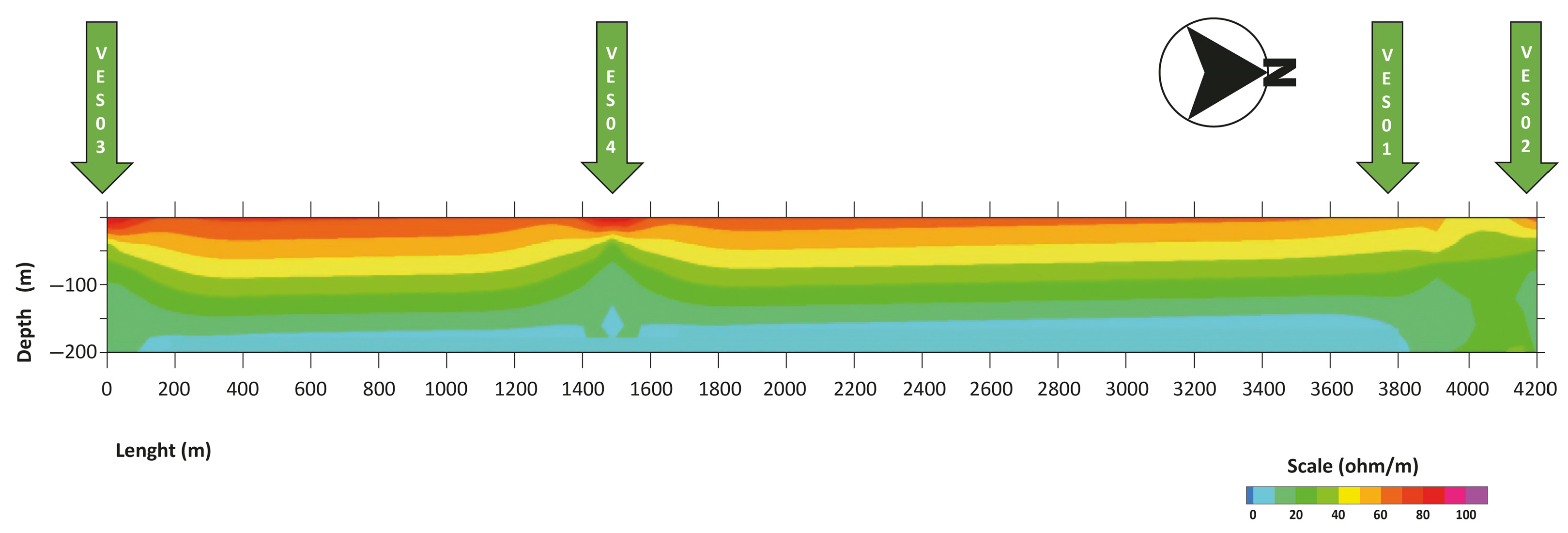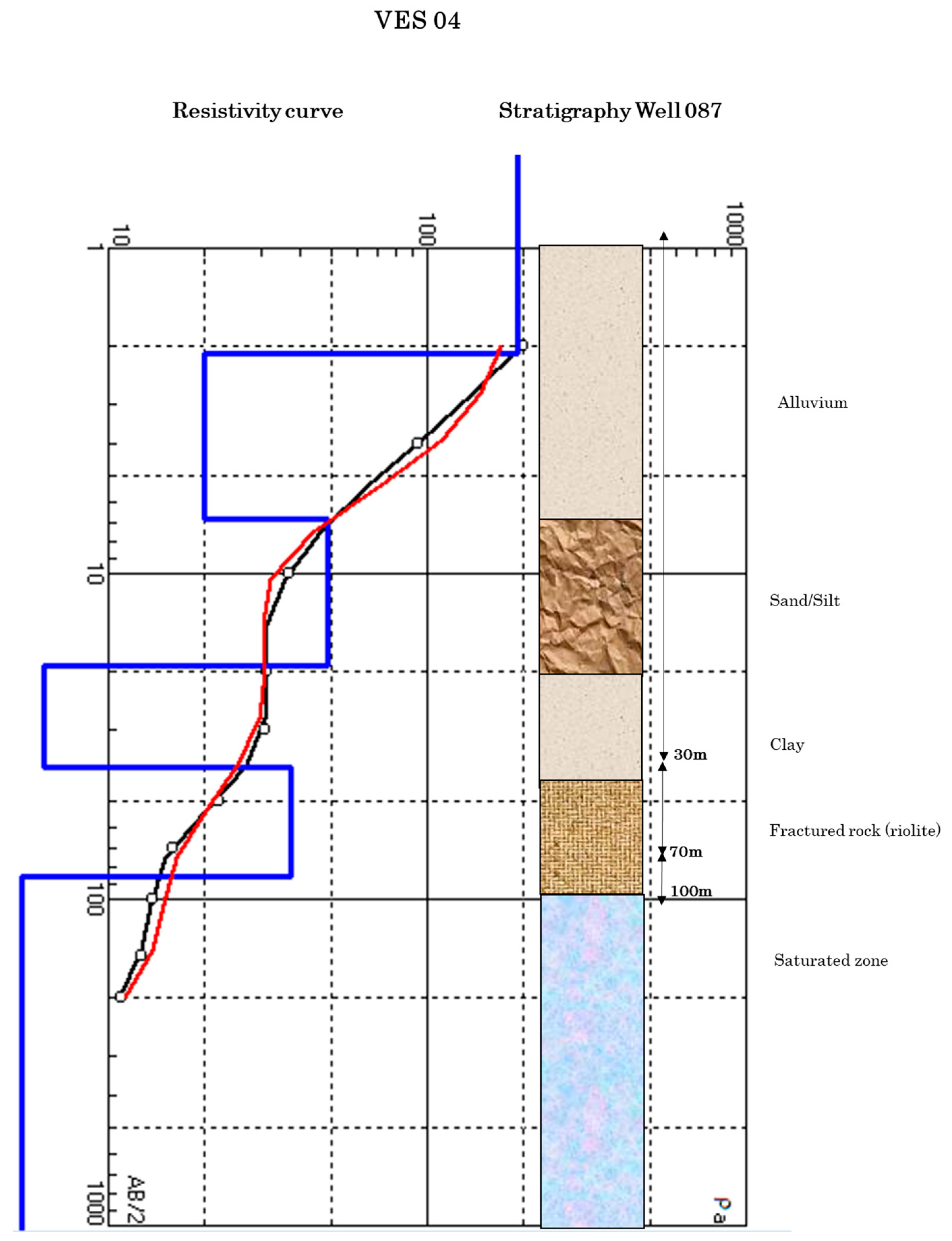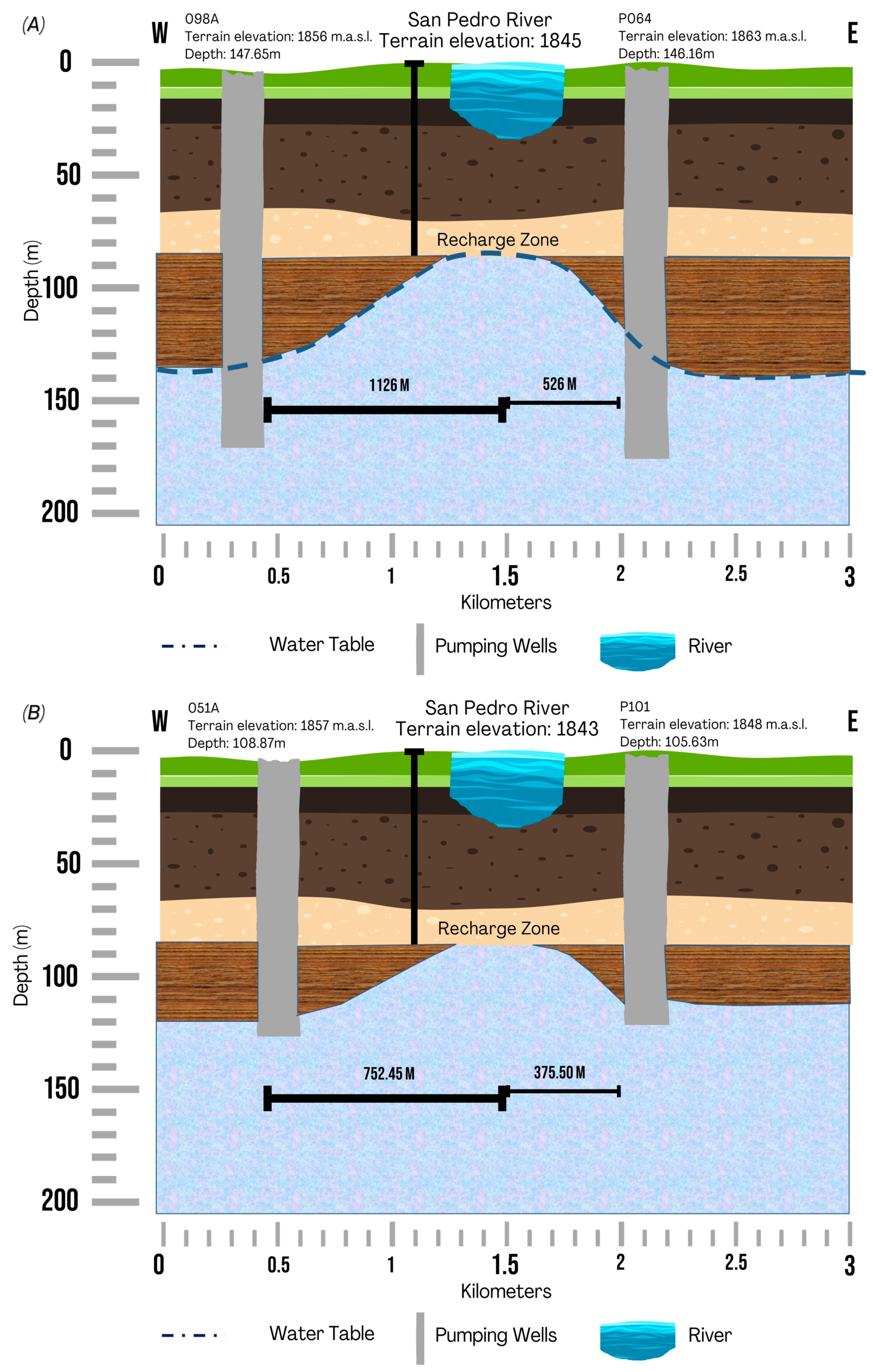Application of Vertical Electrical Sounding and Toxicity Tests for the Analysis of Vertical Hydraulic Connectivity through the Vadose Zone
Abstract
:1. Introduction
2. Materials and Methods
2.1. Characteristics of the Study Area (Aguascalientes; Mexico)
2.2. Methodology
3. Results
3.1. Geospatial Stage
3.2. Hydraulic Stage
3.3. Geophysical Stage
3.4. Hydrogeochemical Stage
4. Discussion
Vertical Connectivity Zones Located between Vertical Electrical Soundings Data and Hydraulic Modeling
5. Conclusions
Author Contributions
Funding
Data Availability Statement
Acknowledgments
Conflicts of Interest
References
- Mussabek, D.; Söderman, A.; Imura, T.; Persson, K.M.; Nakagawa, K.; Ahrens, L.; Berndtsson, R. PFAS in the Drinking Water Source: Analysis of the Contamination Levels, Origin and Emission Rates. Water 2023, 15, 137. [Google Scholar] [CrossRef]
- Kikuda, R.; Pereira Gomes, R.; Rodrigues Gama, A.; De Paula Silva, J.A.; Pereira Dos Santos, A.; Rodrigues Alves, K.; Nascimento Arruda, P.; Scalize, P.S.; Gonçalves Vieira, J.D.; Carneiro, L.C.; et al. Evaluation of Water Quality of Buritis Lake. Water 2022, 14, 1414. [Google Scholar] [CrossRef]
- Salinas-Rodríguez, S.A.; van de Giesen, N.C.; McClain, M.E. Inter-Annual and Seasonal Variability of Flows: Delivering Climate-Smart Environmental Flow Reference Values. Water 2022, 14, 1489. [Google Scholar] [CrossRef]
- Rodrigues, S.; Xavier, B.; Nogueira, S.; Antunes, S.C. Intermittent Rivers as a Challenge for Freshwater Ecosystems Quality Evaluation: A Study Case in the Ribeira de Silveirinhos, Portugal. Water 2023, 15, 17. [Google Scholar] [CrossRef]
- Zhang, Q.; Cui, Y.; Chen, Y.D. Ecological Flow Evaluation Based on Hydrological Alterations in the Dongjiang River Basin. J. Nat. Resour. 2012, 27, 790–800. [Google Scholar]
- Datry, T.; Larned, S.T.; Tockner, K. Intermittent Rivers: A Challenge for Freshwater Ecology. BioScience 2014, 64, 229–235. [Google Scholar] [CrossRef]
- Leigh, C.; Boulton, A.J.; Courtwright, J.L.; Fritz, K.; May, C.L.; Walker, R.H.; Datry, T. Ecological Research and Management of Intermittent Rivers: An Historical Review and Future Directions. Freshw. Biol. 2016, 61, 1181–1199. [Google Scholar] [CrossRef]
- Gómez-Balandra, M.A.; del, P. Saldaña-Fabela, M.; Llerandi-Juárez, R.D. Environmental Approaches during Planning and Construction Stages of Hydropower Projects in Mexico. J. Environ. Prot. 2015, 6, 1186. [Google Scholar] [CrossRef]
- Połeć, K.; Grzywna, A.; Tarkowska-Kukuryk, M.; Bronowicka-Mielniczuk, U. Changes in the Ecological Status of Rivers Caused by the Functioning of Natural Barriers. Water 2022, 14, 1522. [Google Scholar] [CrossRef]
- Shin, J.; Hwang, S.; Jung, S.H.; Han, W.S.; Son, J.-S.; Nam, M.J.; Kim, T. Development of Site-Scale Conceptual Model Using Integrated Borehole Methods: Systematic Approach for Hydraulic and Geometric Evaluation. Water 2022, 14, 1336. [Google Scholar] [CrossRef]
- Delso, J.; Magdaleno, F.; Fernández-Yuste, J.A. Flow Patterns in Temporary Rivers: A Methodological Approach Applied to Southern Iberia. Hydrol. Sci. J. 2017, 62, 1551–1563. [Google Scholar] [CrossRef]
- Ma, C.; Qiu, D.; Mu, X.; Gao, P. Morphological Evolution Characteristics of River Cross-Sections in the Lower Weihe River and Their Response to Streamflow and Sediment Changes. Water 2022, 14, 3419. [Google Scholar] [CrossRef]
- Conallin, J.; Wilson, E.; Campbell, J. Implementation of Environmental Flows for Intermittent River Systems: Adaptive Management and Stakeholder Participation Facilitate Implementation. Environ. Manag. 2017, 1–9. [Google Scholar] [CrossRef] [PubMed]
- Hernández-Marín, M.; Guerrero-Martínez, L.; Zermeño-Villalobos, A.; Rodríguez-González, L.; Burbey, T.J.; Pacheco-Martínez, J.; Martínez-Martínez, S.I.; González-Cervantes, N. Spatial and Temporal Variation of Natural Recharge in the Semi-Arid Valley of Aguascalientes, Mexico. Hydrogeol. J. 2018, 26, 2811–2826. [Google Scholar] [CrossRef]
- Guzmán-Colis, G.; Thalasso, F.; Ramírez-López, E.M.; Rodríguez-Narciso, S.; Guerrero-Barrera, A.L.; Avelar-González, F.J. Evaluación Espacio-Temporal de La Calidad Del Agua Del Río San Pedro En El Estado de Aguascalientes, México. Rev. Int. Contam. Ambient. 2011, 27, 89–102. [Google Scholar]
- Andrade, R.; Rangarajan, R. Transient Resistivity Response to Infiltrating Water Front through Vadose Zone. HydroResearch 2019, 2, 12–20. [Google Scholar] [CrossRef]
- Ikard, S.J.; Carroll, K.C.; Rucker, D.F.; Teeple, A.P.; Tsai, C.-H.; Payne, J.D.; Fuchs, E.H.; Jamil, A. Geoelectric Monitoring of the Electric Potential Field of the Lower Rio Grande before, during, and after Intermittent Streamflow, May–October, 2022. Water 2023, 15, 1652. [Google Scholar] [CrossRef]
- Pacheco-Guerrero, A.; Goodrich, D.C.; González-Trinidad, J.; Júnez-Ferreira, H.E.; Bautista-Capetillo, C.F. Flooding in Ephemeral Streams: Incorporating Transmission Losses. J. Maps 2017, 13, 350–357. [Google Scholar] [CrossRef]
- Hansen, A.M.; Lara, F.; Ortiz, G.; Trejo, P. Recarga Artificial de Acuíferos Con Agua Residual Tratada. In Inf. Bull.; Mexican Institute of Water Technology: Jiutepec, Mexico, 1997. [Google Scholar]
- Cigna, F.; Tapete, D. Satellite InSAR Survey of Structurally-Controlled Land Subsidence Due to Groundwater Exploitation in the Aguascalientes Valley, Mexico. Remote Sens. Environ. 2021, 254, 112254. [Google Scholar] [CrossRef]
- Song, H.; Zhang, J.; Zuo, J.; Liang, X.; Han, W.; Ge, J. Subsidence Detection for Urban Roads Using Mobile Laser Scanner Data. Remote Sens. 2022, 14, 2240. [Google Scholar] [CrossRef]
- Luna-Villavicencio, H.; Pacheco-Martínez, J.; Ochoa-González, G.H.; Hernández-Marín, M.; Hernández-Madrigal, V.M.; López-Doncel, R.A.; Reyes-Cedeño, I.G. Determination of Susceptibility to the Generation of Discontinuities Related to Land Subsidence Using the Frequency Ratio Method in the City of Aguascalientes, Mexico. Remote Sens. 2023, 15, 2597. [Google Scholar] [CrossRef]
- Lermo, J.; Nieto-Obregón, J.; Zermeño, M. Faults and Fractures in the Valley of Aguascalientes. Preliminary Microzonification. In Proceedings of the Eleventh World Conference on Earthquake Engineering, Acapulco, Mexico, 23–28 June 1996; pp. 23–28. [Google Scholar]
- Aranda-Gómez, J.J. Geología Preliminar Del Graben de Aguascalientes. In Revista del Instituto de Geología; Universidad Nacional Autónoma de México: Mexico City, Mexico, 1989; Volume 8, pp. 22–32. [Google Scholar]
- Avelar González, F.J.A.; Ramírez López, E.M.R.; Martínez Saldaña, M.C.M.; Guerrero Barrera, A.L.G.; Juárez, F.J.; Reyes Sánchez, J.L.R. Water Quality in the State of Aguascalientes and Its Effects on the Population’s Health. In Water Resources in Mexico: Scarcity, Degradation, Stress, Conflicts, Management, and Policy; Hexagon Series on Human and Environmental Security and Peace; Springer: Berlin/Heidelberg, Germany, 2011; pp. 217–229. [Google Scholar] [CrossRef]
- Ramirez Castillo, F.Y.; Avelar González, F.J.; Garneau, P.; Marquez Diaz, F.; Guerrero Barrera, A.L.; Harel, J. Presence of Multi-Drug Resistant Pathogenic Escherichia Coli in the San Pedro River Located in the State of Aguascalientes, Mexico. Front. Microbiol. 2013, 4. [Google Scholar] [CrossRef] [PubMed]
- Richter, B.D.; Mathews, R.; Harrison, D.L.; Wigington, R. Ecologically Sustainable Water Management: Managing River Flows for Ecological Integrity. Ecol. Appl. 2003, 13, 206–224. [Google Scholar] [CrossRef]
- Bautista-de-los-Santos, Q.M. Determinación de caudales ambientales en la cuenca del río Yuna, República Dominicana. Tecnol. Cienc. Agua 2014, 5, 33–40. [Google Scholar]
- Reyes-Cedeño, I.G.; Hernández-Marín, M.; Pacheco-Guerrero, A.I.; Gannon, J.P. Comprehensive Methodology and Analysis to Determine the Environmental Flow Regime in the Temporary Stream “La Yerbabuena” in Aguascalientes, Mexico. Water 2023, 15, 879. [Google Scholar] [CrossRef]
- CNA. Map of Piezometric Wells 2021. 2021. Available online: https://sigagis.conagua.gob.mx/rp20/ (accessed on 13 December 2023).
- Ghosh, D.P. The Application of Linear Filter Theory to the Direct Interpretation of Geoelectrical Resistivity Sounding Measurements*. Geophys. Prospect. 1971, 19, 192–217. [Google Scholar] [CrossRef]
- Kirsch, R. Groundwater Geophysics: A Tool for Hydrogeology; Springer Science & Business Media: Berlin/Heidelberg, Germany, 2006. [Google Scholar]
- Tovar-Aguilar, G.I.; Arzate-Cardenas, M.A.; Rico-Martínez, R. Effects of Diclofenac on the Freshwater Rotifer Lecane papuana (Murray, 1913) (Monogononta: Lecanidae). Hidrobiológica 2019, 29, 63–72. [Google Scholar] [CrossRef]
- Mathews, R.; Richter, B.D. Application of the Indicators of Hydrologic Alteration Software in Environmental Flow Setting. JAWRA J. Am. Water Resour. Assoc. 2007, 43, 1400–1413. [Google Scholar] [CrossRef]
- Li, D.; Wan, W.; Zhao, J. Optimizing Environmental Flow Operations Based on Explicit Quantification of IHA Parameters. J. Hydrol. 2018, 563, 510–522. [Google Scholar] [CrossRef]
- Yang, P.; Yin, X.-A.; Yang, Z.-F.; Tang, J. A Revised Range of Variability Approach Considering the Periodicity of Hydrological Indicators. Hydrol. Process. 2014, 28, 6222–6235. [Google Scholar] [CrossRef]
- Lowrie, W.; Fichtner, A. Fundamentals of Geophysics; Cambridge University Press: Cambridge, UK, 2020. [Google Scholar]












| HAS | Influent (%) | Effluent * (%) | |
|---|---|---|---|
| 1 (one) | LC01 | 20.43 (15.57–25.28) | >95 |
| LC10 | 30.49 (26.90–34.08) | >100 | |
| LC50 | 44.01 (41.51–46.52) | >100 | |
| 2 (two) | LC01 | 30.57 (23.74–37.39) | >95 |
| LC10 | 40.80 (35.69–45.92) | >100 | |
| LC50 | 53.17 (50.14–56.19) | >100 | |
| 3 (three) | LC01 | 5.94 (1.95–9.93) | >95 |
| LC10 | 18.19 (13.34–23.04) | >100 | |
| LC50 | 50.74 (33.65–67.82) | >100 |
| Well ID | X-Coordinates (m) | Y-Coordinates (m) | Distance to San Pedro River (m) | Topographic Difference between Wellhead and River Bed (m) |
|---|---|---|---|---|
| P002 | 777,406.524 | 2,422,221.559 | 747.34 | 12 |
| P046A | 777,550.769 | 2,425,089.548 | 742.84 | 24 |
| P051A | 775,819.371 | 2,421,726.304 | 752.45 | 18 |
| P054 | 777,455.599 | 2,424,441.877 | 564.081 | 21 |
| P057 | 777,465.116 | 2,424,075.273 | 722.02 | 18 |
| P064 | 777,114.378 | 2,425,269.177 | 505.68 | 17 |
| P066 | 777,128.345 | 2,423,937.525 | 761.82 | 11 |
| P066A | 776,054.894 | 2,423,090.543 | 366.27 | 6 |
| P067 | 777,277.225 | 2,423,465.874 | 959.28 | 18 |
| P070A | 775,622.989 | 2,418,917.316 | 512.16 | 7 |
| P075 | 777,136.953 | 2,418,821.750 | 993.37 | 15 |
| P076 | 776,951.95 | 2,419,347.070 | 154.99 | 8 |
| P079 | 776,449.643 | 2,420,869.657 | 401.01 | 8 |
| P081 | 776,287.210 | 2,427,283.600 | 420.6 | 24 |
| P097A | 774,914.191 | 2,423,233.058 | 576.15 | 25 |
| P098 | 775,439.328 | 2,426,695.966 | 653.65 | 18 |
| P098A | 775,658.942 | 2,426,077.059 | 814.09 | 10 |
| P101 | 777,228.210 | 2,420,943.063 | 375.5 | 8 |
| P102 | 777,600.264 | 2,423,000.040 | 917.34 | 16 |
| P106A | 775,682.549 | 2,419,836.920 | 540.35 | 21 |
| P107 | 775,547.258 | 2,419,586.371 | 672.8 | 25 |
| P113 | 777,175.527 | 2,426,679.710 | 722.4 | 23 |
| P119A | 776,307.278 | 2,427,673.988 | 900.3 | 22 |
| P155 | 776,677.957 | 2,420,381.110 | 154.5 | 3 |
| P184 | 775,129.701 | 2,418,642.189 | 722.12 | 23 |
Disclaimer/Publisher’s Note: The statements, opinions and data contained in all publications are solely those of the individual author(s) and contributor(s) and not of MDPI and/or the editor(s). MDPI and/or the editor(s) disclaim responsibility for any injury to people or property resulting from any ideas, methods, instructions or products referred to in the content. |
© 2024 by the authors. Licensee MDPI, Basel, Switzerland. This article is an open access article distributed under the terms and conditions of the Creative Commons Attribution (CC BY) license (https://creativecommons.org/licenses/by/4.0/).
Share and Cite
Reyes-Cedeño, I.G.; Hernández-Marín, M.; Pacheco-Martínez, J.; Rico-Martínez, R.; Arzate-Cárdenas, M.A.; Pacheco-Guerrero, A.; Luna-Villavicencio, H.; Padilla-Ceniceros, R. Application of Vertical Electrical Sounding and Toxicity Tests for the Analysis of Vertical Hydraulic Connectivity through the Vadose Zone. Water 2024, 16, 222. https://doi.org/10.3390/w16020222
Reyes-Cedeño IG, Hernández-Marín M, Pacheco-Martínez J, Rico-Martínez R, Arzate-Cárdenas MA, Pacheco-Guerrero A, Luna-Villavicencio H, Padilla-Ceniceros R. Application of Vertical Electrical Sounding and Toxicity Tests for the Analysis of Vertical Hydraulic Connectivity through the Vadose Zone. Water. 2024; 16(2):222. https://doi.org/10.3390/w16020222
Chicago/Turabian StyleReyes-Cedeño, Isaí Gerardo, Martín Hernández-Marín, Jesús Pacheco-Martínez, Roberto Rico-Martínez, Mario Alberto Arzate-Cárdenas, Anuard Pacheco-Guerrero, Hugo Luna-Villavicencio, and Raudel Padilla-Ceniceros. 2024. "Application of Vertical Electrical Sounding and Toxicity Tests for the Analysis of Vertical Hydraulic Connectivity through the Vadose Zone" Water 16, no. 2: 222. https://doi.org/10.3390/w16020222
APA StyleReyes-Cedeño, I. G., Hernández-Marín, M., Pacheco-Martínez, J., Rico-Martínez, R., Arzate-Cárdenas, M. A., Pacheco-Guerrero, A., Luna-Villavicencio, H., & Padilla-Ceniceros, R. (2024). Application of Vertical Electrical Sounding and Toxicity Tests for the Analysis of Vertical Hydraulic Connectivity through the Vadose Zone. Water, 16(2), 222. https://doi.org/10.3390/w16020222










